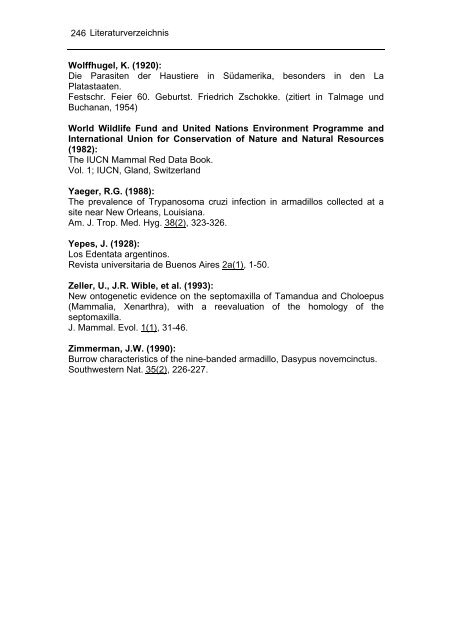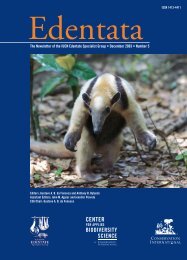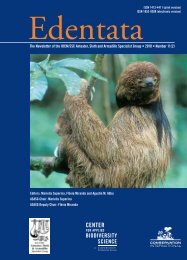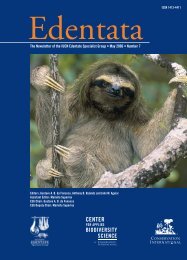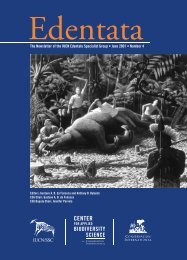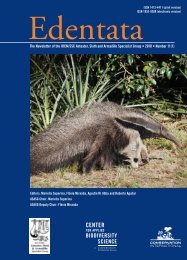- Seite 1 und 2:
Aus dem Departement für Fortpflanz
- Seite 3 und 4:
2 Inhaltsverzeichnis 2.10 Physiolog
- Seite 5 und 6:
4 Inhaltsverzeichnis 3.9.5 Erkranku
- Seite 7 und 8:
6 Abkürzungen Im Text verwendete A
- Seite 9 und 10:
8 Einleitung 1.2 Material und Metho
- Seite 11 und 12:
10 Einleitung Pathologien: Leider w
- Seite 13 und 14:
12 Allgemeine Informationen kleiner
- Seite 15 und 16:
14 Allgemeine Informationen 2.4 Tax
- Seite 17 und 18:
16 Allgemeine Informationen Korrekt
- Seite 19 und 20:
18 Allgemeine Informationen Cabasso
- Seite 21 und 22:
20 Allgemeine Informationen 2.6.4 E
- Seite 23 und 24:
22 Allgemeine Informationen nach No
- Seite 25 und 26:
24 Allgemeine Informationen 4. Auge
- Seite 27 und 28:
26 Allgemeine Informationen 16. Sch
- Seite 29 und 30:
28 Allgemeine Informationen 29. Rü
- Seite 31 und 32:
30 Allgemeine Informationen - Cerra
- Seite 33 und 34:
32 Allgemeine Informationen wenig V
- Seite 35 und 36:
34 Allgemeine Informationen Mündun
- Seite 37 und 38:
36 Allgemeine Informationen Dasypus
- Seite 39 und 40:
38 Allgemeine Informationen In der
- Seite 41 und 42:
40 Allgemeine Informationen Genus T
- Seite 43 und 44:
42 Allgemeine Informationen Dasypus
- Seite 45 und 46:
44 Allgemeine Informationen davon m
- Seite 47 und 48:
46 Allgemeine Informationen kann da
- Seite 49 und 50:
48 Allgemeine Informationen sulfati
- Seite 51 und 52:
50 Allgemeine Informationen • Lnn
- Seite 53 und 54:
52 Allgemeine Informationen Ameisen
- Seite 55 und 56:
54 Allgemeine Informationen Samenbl
- Seite 57 und 58:
56 Allgemeine Informationen Tempera
- Seite 59 und 60:
58 Allgemeine Informationen vielmeh
- Seite 61 und 62:
60 Allgemeine Informationen Torpidi
- Seite 63 und 64:
62 Allgemeine Informationen Gürtel
- Seite 65 und 66:
64 Allgemeine Informationen Im Somm
- Seite 67 und 68:
66 Allgemeine Informationen weggekr
- Seite 69 und 70:
68 Allgemeine Informationen gemäss
- Seite 71 und 72:
70 Allgemeine Informationen 2.12.2
- Seite 73 und 74:
72 Allgemeine Informationen 2.12.4
- Seite 75 und 76:
* verzögerte Implantation 1 Gemäs
- Seite 77 und 78:
76 Allgemeine Informationen Die gem
- Seite 79 und 80:
78 Allgemeine Informationen geschwu
- Seite 81 und 82:
80 Allgemeine Informationen herausg
- Seite 83 und 84:
82 Allgemeine Informationen Tiefe v
- Seite 85 und 86:
84 Allgemeine Informationen moschus
- Seite 87 und 88:
86 Allgemeine Informationen kann. A
- Seite 89 und 90:
88 Allgemeine Informationen Neunbin
- Seite 91 und 92:
90 Allgemeine Informationen fortpfl
- Seite 93 und 94:
92 Allgemeine Informationen 2.14.2
- Seite 95 und 96:
94 Allgemeine Informationen novemci
- Seite 97 und 98:
96 Allgemeine Informationen Endopar
- Seite 99 und 100:
98 Allgemeine Informationen Strongy
- Seite 101 und 102:
100 Allgemeine Informationen 2.14.4
- Seite 103 und 104:
102 Allgemeine Informationen Lepra,
- Seite 105 und 106:
104 Allgemeine Informationen Fall e
- Seite 107 und 108:
106 Haltung in Menschenobhut Tolype
- Seite 109 und 110:
108 Haltung in Menschenobhut 3.3.2
- Seite 111 und 112:
110 Haltung in Menschenobhut Gürte
- Seite 113 und 114:
112 Haltung in Menschenobhut zu hal
- Seite 115 und 116:
114 Haltung in Menschenobhut gesche
- Seite 117 und 118:
116 Haltung in Menschenobhut Weiter
- Seite 119 und 120:
118 Haltung in Menschenobhut 200g H
- Seite 121 und 122:
120 Haltung in Menschenobhut 3.4.5
- Seite 123 und 124:
Tabelle 5: Hämatologie D.novemcinc
- Seite 125 und 126:
124 Haltung in Menschenobhut Tabell
- Seite 127 und 128:
126 Haltung in Menschenobhut Urogen
- Seite 129 und 130:
128 Haltung in Menschenobhut dem er
- Seite 131 und 132:
130 Haltung in Menschenobhut Berüc
- Seite 133 und 134:
132 Haltung in Menschenobhut 3.6.2
- Seite 135 und 136:
134 Haltung in Menschenobhut haltig
- Seite 137 und 138:
136 Haltung in Menschenobhut 3.7 Et
- Seite 139 und 140:
138 Haltung in Menschenobhut Jungti
- Seite 141 und 142:
140 Haltung in Menschenobhut Eine g
- Seite 143 und 144:
142 Haltung in Menschenobhut 3.9.2
- Seite 145 und 146:
144 Haltung in Menschenobhut und Fu
- Seite 147 und 148:
146 Haltung in Menschenobhut Hypoka
- Seite 149 und 150:
148 Haltung in Menschenobhut 3.9.8.
- Seite 151 und 152:
150 Haltung in Menschenobhut Fraktu
- Seite 153 und 154:
152 Haltung in Menschenobhut Präme
- Seite 155 und 156:
154 Haltung in Menschenobhut Tabell
- Seite 157 und 158:
156 Haltung in Menschenobhut um Pat
- Seite 159 und 160:
158 Resultate der Umfrage 4 Resulta
- Seite 161 und 162:
160 Resultate der Umfrage Bei der G
- Seite 163 und 164:
162 Resultate der Umfrage Offengehe
- Seite 165 und 166:
Tabelle 23: Futterzusammensetzung i
- Seite 167 und 168:
166 Resultate der Umfrage 4.5 Zucht
- Seite 169 und 170:
168 Resultate der Umfrage Tabelle 2
- Seite 171 und 172:
170 Resultate der Umfrage Tabelle 3
- Seite 173 und 174:
172 Resultate der Umfrage Pathologi
- Seite 175 und 176:
174 Resultate der Umfrage Tabelle 3
- Seite 177 und 178:
176 Diskussion 5 Diskussion 5.1 Sin
- Seite 179 und 180:
178 Diskussion durchsetzbar: Auch R
- Seite 181 und 182:
180 Diskussion für kleine und mitt
- Seite 183 und 184:
182 Diskussion Die Tierschutzverord
- Seite 185 und 186:
184 Diskussion installieren, welche
- Seite 187 und 188:
186 Diskussion 5.4 Fütterung Der A
- Seite 189 und 190:
188 Diskussion Bei der Fütterung v
- Seite 191 und 192:
190 Diskussion 5.5 Reproduktion Die
- Seite 193 und 194:
192 Diskussion Menschenobhut zur We
- Seite 195 und 196: 194 Diskussion erschreckend, sollte
- Seite 197 und 198: 196 Diskussion 5.7 Ethologie 5.7.1
- Seite 199 und 200: 198 Diskussion 5.7.2 Behavioral enr
- Seite 201 und 202: 200 Diskussion 5.8 Schlussfolgerung
- Seite 203 und 204: 202 Zusammenfassung macht deutlich,
- Seite 205 und 206: 204 Summary The maintenance of arma
- Seite 207 und 208: 206 Anhang Haltung Wie gross ist di
- Seite 209 und 210: 208 Anhang Pathologien Wie alt sind
- Seite 211 und 212: 210 Literaturverzeichnis 9 Literatu
- Seite 213 und 214: 212 Literaturverzeichnis Barretto,
- Seite 215 und 216: 214 Literaturverzeichnis Burchfield
- Seite 217 und 218: 216 Literaturverzeichnis Chandler,
- Seite 219 und 220: 218 Literaturverzeichnis de Jong, W
- Seite 221 und 222: 220 Literaturverzeichnis Enders, A.
- Seite 223 und 224: 222 Literaturverzeichnis Gauna-Aña
- Seite 225 und 226: 224 Literaturverzeichnis Herbst, L.
- Seite 227 und 228: 226 Literaturverzeichnis Khalil, M.
- Seite 229 und 230: 228 Literaturverzeichnis Loughry, W
- Seite 231 und 232: 230 Literaturverzeichnis McDonough,
- Seite 233 und 234: 232 Literaturverzeichnis Moore, D.M
- Seite 235 und 236: 234 Literaturverzeichnis Owen, R. (
- Seite 237 und 238: 236 Literaturverzeichnis Quevedo, F
- Seite 239 und 240: 238 Literaturverzeichnis Sandell, M
- Seite 241 und 242: 240 Literaturverzeichnis Squarcia,
- Seite 243 und 244: 242 Literaturverzeichnis Thomas, O.
- Seite 245: 244 Literaturverzeichnis Vogelsang-


